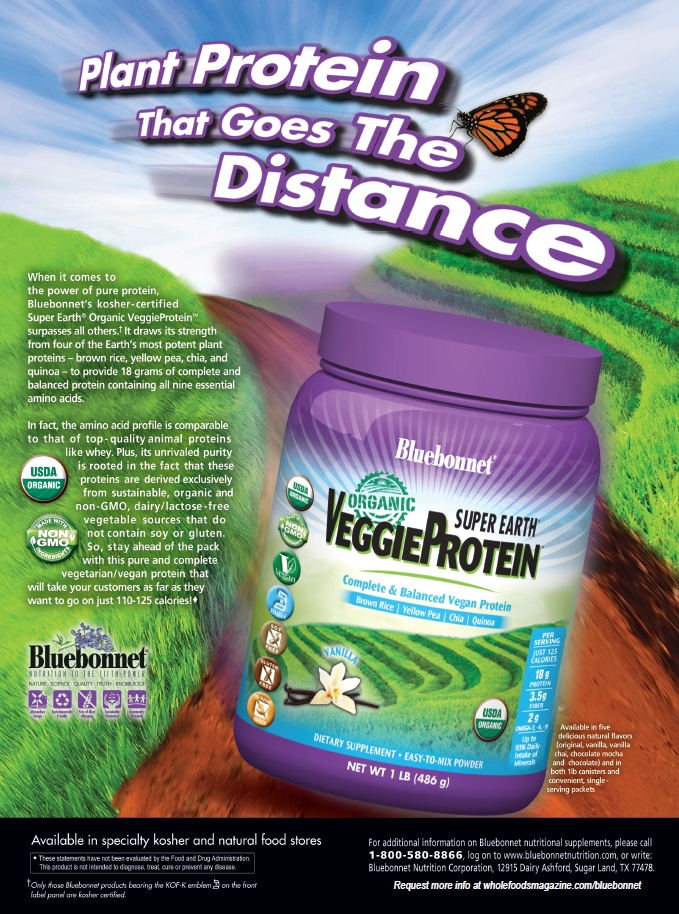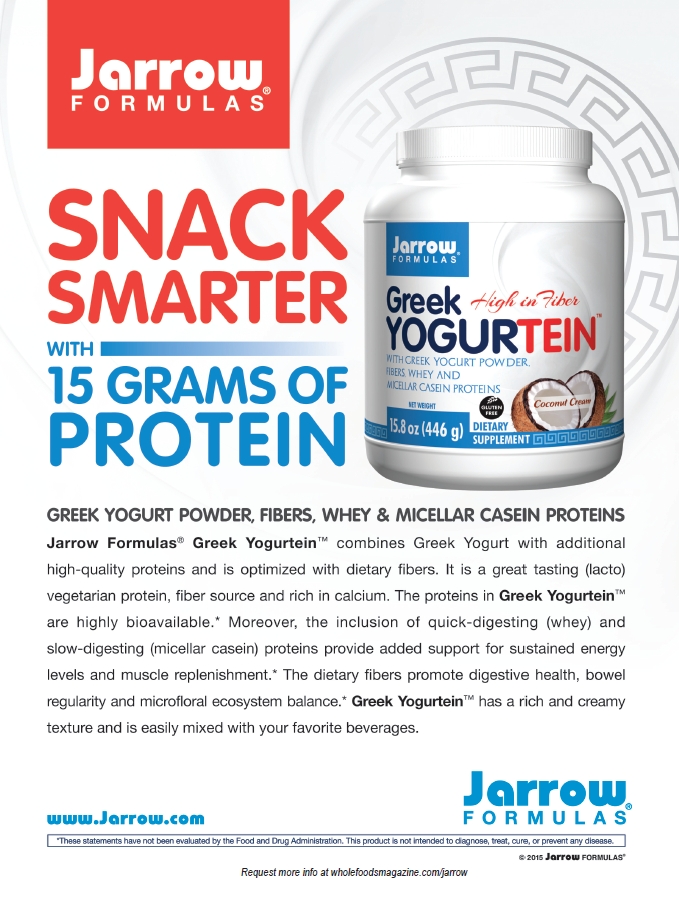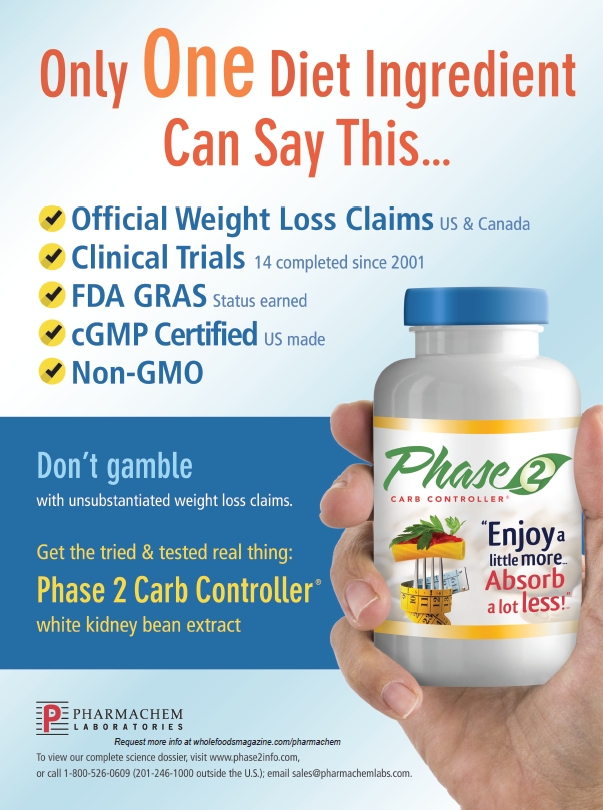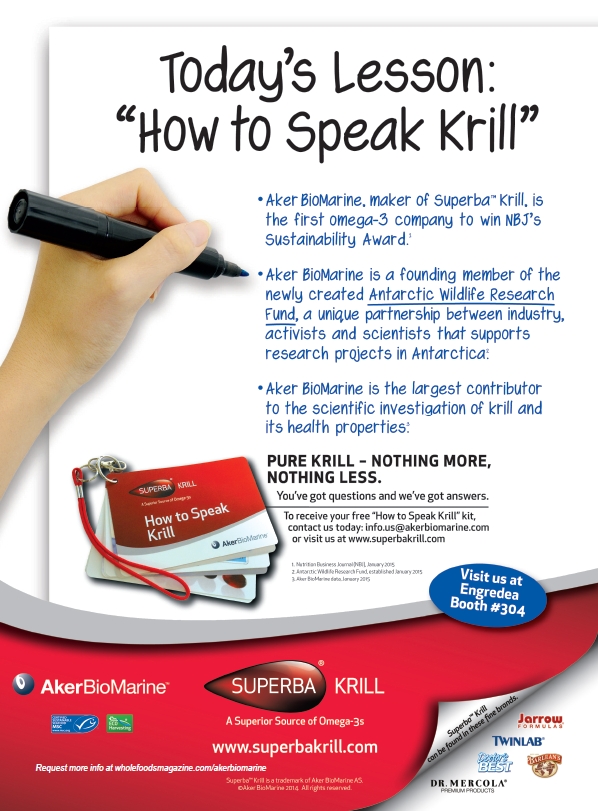“To thine own self be true,” may be one of the most famous lines from Hamlet, and it’s good advice for the weight management category. For years, the concept of “healthy weight management” has butted heads with those “lose 10 pounds in a week” products that are based on empty promises and fuel unrealistic (and unhealthy) expectations. The category would be better served if they all were truthful about what they can and cannot do.
“One of the biggest challenges within this category is trying to compete with companies that make outrageous claims about the benefits their products provide,” states Susan Hazels Mitmesser, Ph.D., director of nutrition research at Solgar, Leonia, NJ. “Products that tout rapid and permanent effects on weight loss are usually based more on hype than solid clinical evidence.”
What’s a retailer to do? Walk shoppers through the main ways to support healthy weight management, help customers choose the best strategy for them and underscore the fact that there’s no substitute for a healthy diet and exercise.
Says Hazels Mitmesser, “Educated consumers know that diet and exercise go hand-in-hand and are the key principles for weight management. Therefore, any supplements that can support their exercise performance and/or recovery can also help them to meet their body-shaping goals.”
Conquering Fat Phobia
Consuming fats to lose weight may seem counterintuitive for new natural products shoppers. But, there are numerous good reasons to consume healthy fats, and achieving a healthy body mass is among them.
“Unbelievably, fat is good for you and even  healthy for you,” says Trisha Sugarek MacDonald, B.S., M.S., director of R&D and national educator for Bluebonnet Nutrition Corporation, Sugar Land, TX. “But surprisingly, we all seem to fear that word ‘FAT’ when reading food labels.”
healthy for you,” says Trisha Sugarek MacDonald, B.S., M.S., director of R&D and national educator for Bluebonnet Nutrition Corporation, Sugar Land, TX. “But surprisingly, we all seem to fear that word ‘FAT’ when reading food labels.”
One might lay some of our fat phobia at the feet of the U.S. Department of Public Health and the U.S. Surgeon General, which have long encouraged Americans to eat less fat with the false assumption that eating any fat makes us fat. Of course, this theory discounts the entire notion of healthy fats.
The end result has been a surge of low-fat and fat-free foods on the market—which also tend to be high carb, not satisfying and the source of unwanted weight gain. “The growth of obesity in the U.S has been fueled by the excessive consumption of carbs and ironically many low-fat products replace fat with carbs, helping to contribute to the overload,” states Daniel Lifton, CEO of Quality of Life Labs, Purchase, NY.
Eating good fats may support satiety, says Sugarek MacDonald, and also help ward off cravings for unhealthy fats.
“There is good evidence for the consumption of healthy oils helping to sustain good metabolism of fats,” adds Neil E. Levin, CCN, DANLA, nutrition education manager at NOW Foods, Bloomingdale, IL. “In fact, it has been theorized and there is some evidence that if we lack the good fats in our diet the body will crave more total fats in order to get small amounts of the desired fatty acids, even from those less desirable sources.”
Fats also play a role in cellular health, immune health and healthy inflammation responses. Bruce Topping, national educator with Garden of Life, West Palm Beach, CA, points out that “obesity is really a disease of inflammation in many ways,” and “long-term weight loss is really about reducing inflammation and making all the metabolic signals work properly.”
Different fats affect metabolism differently. Says Les Griffith, chief medical officer at Natrol, LLC, Chatsworth, CA, “When your body is converting calories to fat, it is actually an inflammatory process, so taking anti-inflammatory fats like the omega-3s or fish oil reduces inflammation and lowers your ability to make fat, while omega-6s or vegetable oils can promote inflammation and make it easier to make fat. Omega-9s like olive oil are neutral.”
 In truth, few shoppers truly understand the differences between all the different fats we might consume, so why not add a cheat sheet to your literature rack? According to Herb Joiner-Bey, N.D., scientific advisor to Barlean’s, Ferndale, WA, “The body can distinguish the various kinds of fats we eat based on a number of criteria: length of fatty acids, saturated versus unsaturated, omega-3 versus omega-6 versus omega-9, and more.”
In truth, few shoppers truly understand the differences between all the different fats we might consume, so why not add a cheat sheet to your literature rack? According to Herb Joiner-Bey, N.D., scientific advisor to Barlean’s, Ferndale, WA, “The body can distinguish the various kinds of fats we eat based on a number of criteria: length of fatty acids, saturated versus unsaturated, omega-3 versus omega-6 versus omega-9, and more.”
What are the best options for shoppers?
Linoleic acid. According to Naomi Whittel, founder and CEO of Reserveage, Boca Raton, FL, polyunsaturated and monounsaturated fats should be the top choice. “The polyunsaturated group is particularly important because it provides linoleic and alpha-linoleic acids, which are essential omega-6 and omega-3 fatty acids,” she believes.
Conjugated linoleic acid (CLA, sometimes derived from safflower oil) is said to help support healthy body mass. Retailers may recognize some branded CLA ingredients like Tonalin from BASF and Clarinol from Stepan Lipid Nutrition. According to Joiner-Bey, CLA decreases food energy intake, increases thermogenesis, stops the generation of new fat cells, suppresses the generation of new fats inside fat cells and stimulates triglyceride metabolism inside fat cells.
CLA can be applied directly to food or taken as a supplement prior to meals, says Steven Myers, vice president of Bio Nutrition Inc., Island Park, NY. Its uses may extend beyond weight management: “Further evidence indicates this particular fat may have benefits for heart health,” he states.
Whittel’s company formulates with a high-linoleic safflower oil (SAFActive78 in SafSlim) that she says was shown in clinical tests to reduce belly fat. “This polyunsaturated fat supplement is an example of a product that can be integrated easily into a weight management plan that includes a reduced calorie diet and exercise,” she believes.
In a crossover study involving 35 obese postmenopausal women with type-2 diabetes, participants took 8 g/day of safflower oil or 8 g/day of CLA for 16 weeks each (with a month-long washout period in between). Both  supplements were helpful as CLA reduced body mass index and total adipose mass (without changing lean mass), while SAF reduced trunk adipose mass, increased lean mass, reduced fasting glucose and increased adiponectin (1).
supplements were helpful as CLA reduced body mass index and total adipose mass (without changing lean mass), while SAF reduced trunk adipose mass, increased lean mass, reduced fasting glucose and increased adiponectin (1).
Omega-3s. Joiner-Bey believes omega-3s from sources like flaxseed oil, fish oil and krill oil may help support healthy weight by increasing the number of mitochondria inside of fat cells (which helps metabolize fat) and controlling the number of fat cells in the body.
Emily M. Gonzalez, N.D., senior scientific development associate at Life Extension, Fort Lauderdale, FL, adds that omega-3s from fish oil may also support a healthy weight by benefiting blood pressure, cholesterol and inflammation levels. Citing research, Gonzalez states, “Incorporating lean or oily fish, or fish oil into energy-restricted diets resulted in about 2.2 pounds more loss of weight over four weeks than diets without in a group of 138 overweight and obese men” (2).
MCTs. Medium-chain triglycerides (MCTs) are the “preferred energy sources in cell mitochondria, including fat cells,” says Joiner-Bey. “When MCTs enter mitochondria, they step up metabolism and thermogenesis in cells all over the body. This effect elevates overall body metabolism.”
Levin says MCT oil doesn’t tend to be converted and stored as body fat, and eating this oil with meals may enhance the bioavailability of fat-soluble nutrients.
Coconut oil, which was once vilified as an unhealthy saturated fat, contains MCTs. “It turns out that saturated fats like butter and coconut oil are very stable and won’t easily be damaged during heating and cooking,” says Topping. He recommends avoiding trans fats, damaged oils (like hydrogenated oils) and delicate oils that are exposed to high heat (like soybean or canola oil), and instead cooking with two tablespoons of coconut oil, olive oil and butter made from the milk of grass-fed cows.
Block It Out
While healthy fats are good for you, others should be avoided. Some weight management products focus on this very idea: blocking unwanted fats and carbs.
 “The safe and effective inhibition of excessive dietary fat absorption is an important mechanism in controlling metabolic disorders including prediabetes, diabetes, metabolic syndrome and obesity,” states Vladimir Badmaev, M.D., Ph.D., founder and medical advisor, American Medical Holdings, Inc., New York, NY.
“The safe and effective inhibition of excessive dietary fat absorption is an important mechanism in controlling metabolic disorders including prediabetes, diabetes, metabolic syndrome and obesity,” states Vladimir Badmaev, M.D., Ph.D., founder and medical advisor, American Medical Holdings, Inc., New York, NY.
But, some education on these products is required. Here’s how they work. According to Paul Dijkstra, CEO of InterHealth Nutraceuticals, Benicia, CA, carb/starch blockers prevent or delay carb absorption by inhibiting the enzymes that break down carbs, including amylase and alpha-glucosidases. Some companies selling carb blockers choose prickly pear, cactus, Salacia reticulata and gymnema, but “most use a protein extract of the white kidney bean as the active ingredient,” Dijkstra states. One example is the branded Phase 2 from Pharmachem Labs.
Badmaev says white kidney bean extract has much research backing as a weight management ingredient. He states, “The studies ranging from four to 12 weeks supplementation of standardized white kidney bean extract resulted in body weight reduction ranging from four to six pounds.”
When amylase is blocked, carbs can pass through the system without being digested or having a caloric value. Says Gonzalez, “In a placebo-controlled study, those taking white kidney bean extract before meals lost 1.5 inches of abdominal fat over an eight-week period.”
Meanwhile, David Foreman, R.Ph., author and host of the syndicated radio show The Herbal Pharmacist, says, “Most fat blockers don’t actually block fat from being absorbed, but bind fat in the diet and therefore it can’t be digested.”
For example, Gonzalez says that alpha cyclodextrin absorbs nine times its weight in dietary fat without gastrointestinal side effects and shoppers need not worry that their omega-3 efforts are being sabotaged. “While it selectively binds to unhealthy trans fats and saturated fats, it spares healthy omega-3 fats, with one study showing a 13% increase in omega-3 DHA blood levels with the compound,” she states.
Badmaev gives an example of a safe fat-absorption inhibitor. This combination of C. forskohlii, S. reticulata and S. Indicum (FB3 from Bio Actives) inhibits pancreatic lipase activity for weight management support, but avoids unpleasant gastrointestinal issues.
Forskolin is also on the radar of Ryan J. Foley, president and CEO of NuvoCare Health Sciences Inc., Toronto, ON, Canada. He says it can “stimulate the key fat burning hormone in the body known as HSL without negatively effecting heart rate or function.” One branded form (ForsLean, from Sabinsa Corp.) was found in a 12-week study to help subjects lose an average of 9.9 pounds and improve lean body composition, “meaning they did not lose muscle,” says Foley.
Some companies combine fat and carb blockers, with one example coming from Lifton. He states, “Quality of Life often bundles its Carboquel and Lipoquel products since they are very complementary…Carboquel can help reduce the weight-gain impact of consuming pasta…Lipoquel is recommended prior to a meal that contains steak or cheese or other fat-containing products.”
 He explains that its patented extract of the enokitake mushroom (Lipoquel) contains vegetable chitosan, beta-glucans and fatty acids. “The uniquely complexed chitosan binds to dietary fat and ensures that it is excreted from the body rather than absorbed,” he explains. His company’s carb-support product includes Phase 2 Carb Controller and a branded chromium (ChromeMate from InterHealth Nutraceuticals), to support healthy blood sugar levels and help with carb cravings.
He explains that its patented extract of the enokitake mushroom (Lipoquel) contains vegetable chitosan, beta-glucans and fatty acids. “The uniquely complexed chitosan binds to dietary fat and ensures that it is excreted from the body rather than absorbed,” he explains. His company’s carb-support product includes Phase 2 Carb Controller and a branded chromium (ChromeMate from InterHealth Nutraceuticals), to support healthy blood sugar levels and help with carb cravings.
Speaking of dual-action, Foley points out that a branded Cissus Quadrangularis ingredient (Synetrim CQ from Icon Group) inhibits both fat and starch absorption and supports satiety. “[It] caused a 10.5 lbs. weight loss in subjects and a 53.4% increase in plasma serotonin in just 6 weeks. In a second study that followed the same methodology as the first study, subjects lost 19.2 lbs. in 10 weeks,” he states.
Certain blockers may cause gastrointestinal problems, so check with the manufacturer about any known side effects.
Heating Things Up
Shoppers may want to know what thermogenic agents can do for weight management. “Someone who eats relatively healthily but can’t seem to shed those extra pounds might be dealing with a metabolic issue or have a slow metabolism. In that case, a thermogenic product might be more effective,” says Myers.
The body burns ATP for stored calories and fat for energy. Adipose tissue—the fat that lies just below the skin and around the organs—acts as a reserve for ATP and nutrients. Says Sugarek MacDonald, “The use of stored energy for heat helps the body to burn calories, increasing energy expenditure and thereby increasing the basal metabolic rate.”
Thermogenics help maximize the process of energy expenditure for healthy weight management. They generate heat by working with uncoupling proteins (UCPs) inside mitochondria. “UCPs shunt the energy generated from metabolizing fats, starches, sugars and proteins away from the generation of the cell energy currency compound ATP, toward the generation of heat,” says Joiner-Bey.
Several natural ingredients may serve as helpful thermogenics, says Sugarek MacDonald, like naturally occurring methylxanthines (e.g., theobromine, caffeine) and polyphenols. Examples from the latter group are catechins like EGCG. Sugarek MacDonald says her company sources the ingredient from “standardized cocoa, green and black tea extracts that have been proposed as strategies for weight loss and weight maintenance, since they may increase energy expenditure by stimulating thermogenesis and counteracting the decrease in metabolic rate that occurs during weight loss.”
Capsaicinoids are another hot option said to support weight management. Once these compounds are ingested and absorbed, says Lynda Doyle, vice president of global marketing, OmniActive Health Technologies, Morristown, NJ, they stimulate the sympathetic nervous system to release epinephrine and norepinephrine, which spurs the liver to break down glucose and release it into the blood. Norepinephrine also encourages the breakdown of fat into free fatty acids (FFAs) and glycerol. “Glucose and FFAs are picked up by peripheral muscle tissues where they are metabolized to produce high-energy protons,” says Doyle. “This process, referred to as thermogenesis, increases energy expenditure and may impact overall metabolism.”
She explains that capsinoids may affect brown adipose tissue (BAT). “Yoneshiro reported a daily ingestion of 9 mg of capsinoids for six weeks increased cold-induced increments of energy expenditure in individuals with metabolically active BAT, but not in those individuals without it. This indicates that capsinoids activate BAT, thereby increasing energy expenditure which may help decrease body fat (3),” says Doyle.
Beware that some thermogenic supplements contain caffeine. So, Whittel advises “one should take the products as recommended on the label, especially in cases where the products contain caffeine, since excessive caffeine intake can have some undesirable side effects.”
Topping says that these side effects come at a price: “over time, stimulants will tax the adrenal glands and create a vicious cycle of fatigue.”
So, shoppers may not be interested in thermogenic ingredients with stimulants at all, and Dijkstra believes 7-Keto fits the bill because it “maintains metabolic rate when dieting in a non-stimulant manner.” 7-Keto DHEA is a metabolite of dehydroepiandrosterone, which declines in the body with age. Studies suggest the ingredient helps maintain a healthy body weight.
Dijkstra also speaks of another branded ingredient that combines East Indian globe thistle (Sphaeranthus indicus) and purple mangosteen (Garcinia mangostana, Meratrim from InterHealth Nutraceuticals), which is said to support adiponectin levels through several mechanisms including inflammation support with healthy c-reactive protein levels, blood sugar support and lipid formation. States Dijkstra, “In two randomized, double-blind, placebo-controlled clinical studies, Meratrim has been shown to significantly reduce body weight, BMI and waist circumference within two weeks. A good combination idea would be adding 7-Keto for metabolic boost.”
 Another interesting thermogenic is fucoxanthin, which Gonzalez says “activates uncoupling protein-1 that signals fatty acids to generate energy rather than remain stored as body fat.” She feels one important benefit of fucoxanthin’s non-stimulatory action is successful long-term weight management. Her company combines the ingredient with the active ingredient in pomegranate oil (punicic acid) that “reduces blood supply to fat cells and prevents them from increasing in size.”
Another interesting thermogenic is fucoxanthin, which Gonzalez says “activates uncoupling protein-1 that signals fatty acids to generate energy rather than remain stored as body fat.” She feels one important benefit of fucoxanthin’s non-stimulatory action is successful long-term weight management. Her company combines the ingredient with the active ingredient in pomegranate oil (punicic acid) that “reduces blood supply to fat cells and prevents them from increasing in size.”
Topping believes that fucoxanthin has other benefits outside of weight management. “The nice thing is that it was actually found to have positive effects in the liver and absolutely no taxing of the nervous system or adrenal glands,” he states.
According to Griffith, thermogenics are safe because they stimulate a natural process in the body. But, Joiner-Bey adds some precautions for diabetics, since certain weight management products may be problematic for them.
No Hunger Strikes!
No one likes being hungry, and many dieters believe weight management is all about enduring hunger. Not so, says Michael T. Murray, N.D., director of product science and innovation, Natural Factors, Monroe, WA. “The keys to safe and effective weight loss are achieving satiety and supporting the action of insulin,” says Murray.
Matt Phillips, chief commercial officer at Nutegrity, Irvine, CA,  says satiety support may be one of the safest ways to support weight management. “We really believe that the future of supplementation in weight management will be toward satiety inducing products that work, are backed by science and don’t have unwanted side effects,” he states.
says satiety support may be one of the safest ways to support weight management. “We really believe that the future of supplementation in weight management will be toward satiety inducing products that work, are backed by science and don’t have unwanted side effects,” he states.
Murray believes that effective weight management should include PolyGlycopleX (PGX). This complex of natural plant fibers is viscous and has “gel-forming properties, making it many times more effective than any other fiber as a weight loss aid,” Murray states.
When the supplement is taken with a meal, it absorbs water and expands in the stomach over a period of 30 minutes or so, says Murray. This process makes users feel full and slows down digestion. In the end, carbs are absorbed more slowly, which creates a more stable blood sugar response and less food cravings.
In a three-month study on PGX, 29 individuals took 5–15 grams of PGX or inulin daily for 15 weeks. At the end the PGX group lost an average of 3.5 pounds and 1/5” in hip circumference, while the inulin group gained weight and had little hip circumference change.
Soluble fiber is important too, states Brenda Watson, president and founder of Renew Life, Palm Harbor, FL. “[It] is a prebiotic food source for beneficial gut/intestinal flora (probiotics) and helps curb your appetite by helping you feel full,” says Watson.
Retailers may also sell glucomannan, often sourced from the root of the konjac plant. Myers says its bulking fibers expand to many times their volume in the presence of water. “This is the most basic and simple type of satiety product because it takes up space in the stomach creating the full feeling,” he states. Chia also elicits a similar affect.
 There are other strategies for satiety support as well. Dijkstra speaks of a branded hydroxycitric acid (HCA) Garcinia cambogia ingredient from his company called Super CitriMax.
There are other strategies for satiety support as well. Dijkstra speaks of a branded hydroxycitric acid (HCA) Garcinia cambogia ingredient from his company called Super CitriMax.
It works by increasing serotonin levels and activity, which is key for appetite support. The ingredient also is said to inhibit fat production, making it easier to resist cravings, says Foley.
According to Jay Levy, director of sales, Wakunaga of America Co., Ltd., Mission Viejo, CA, “This is the only brand of Garcinia cambogia that has been studied in clinical trials and has been clinically proven to reduce total calorie intake by 15–30%.”
Foley adds that the brand is one of the few with 60% HCA content. “What is unique about Super CitriMax is that the HCA is naturally bound to both calcium and potassium making it more available to the body and it does not cause stomach discomfort that is sometimes caused by old-school 50% HCA garcinia material,” he states.
Gonzalez explains the serotonin connection by saying that “when the brain is flooded with serotonin, satiety normally occurs.” She says individuals who carb-binge for emotional reasons often have a serotonin deficiency and some obese individuals have been found to have low blood tryptophan levels—which may be related to a serotonin deficiency in the brain. “When obese patients were given 1,000 mg, 2,000 mg or 3,000 mg doses of L-tryptophan one hour before meals, a significant decrease in caloric consumption was observed,” Gonzalez states, adding that most of the calorie reduction came from carbs.
Lifton’s company also feels there’s a strong link between serotonin levels and satiety, and the firm offers a product (Pure Balance Serotonin) that combines ingredients for normalizing hormones responsible for appetite regulation like 5-HTP for serotonin balance and Relora to help regulate cortisol. “By regulating and normalizing those hormones, the consumer can experience improved mood, better sleep and less food cravings,” states Lifton.
link between serotonin levels and satiety, and the firm offers a product (Pure Balance Serotonin) that combines ingredients for normalizing hormones responsible for appetite regulation like 5-HTP for serotonin balance and Relora to help regulate cortisol. “By regulating and normalizing those hormones, the consumer can experience improved mood, better sleep and less food cravings,” states Lifton.
Saffron is another ingredient that supports healthy serotonin levels, and Gonzalez offers some information about a branded form called Satiereal (distributed by PLT Health Solutions). She believes it helps reduce snacking by “targeting some of the emotional factors that may cause someone to eat more when they’re trying to eat less.”
Whittel’s company also markets a product (Rebody Hunger Chews and Caps) with this saffron extract. “In an eight-week controlled trial, subjects consuming the ingredient had a reduced desire to snack and snacked less between meals,” she states. The study used a dose of 176.5 mg per day (4). Adds Whittel, “The product is also appealing because it does not contain any stimulant ingredients.”
In addition to saffron, Badmaev likes Sceletium tortuosum for supporting healthy energy and satiety levels in a similar manner to saffron: by “maintaining healthy levels of serotonin and other neuro-hormones.”
Several other satiety-supporting botanicals are also on the market. Levin offers the examples of hoodia and Caralluma fimbriata (Slimaluma from Gencor).
Whittel believes protein supplements can also help those concerned about weight management as “consumption of high-quality protein like whey can produce a satiating effect.”
 Watson says consuming high-protein foods fuels the body, supports satiety and supports healthy metabolism. Protein is said to bind to certain receptors in the gut and relay messages of fullness to the brain.
Watson says consuming high-protein foods fuels the body, supports satiety and supports healthy metabolism. Protein is said to bind to certain receptors in the gut and relay messages of fullness to the brain.
As for the type, Hazels Mitmesser likes whey protein because it is “very easy to digest and contains a low amount of fat.” She also says it supports exercise recovery and is a source of lactoferrin and immunoglobulins.
Phillips agrees, noting “numerous scientific studies over the last 10 years have shown that proteins are potent appetite-suppressing agents.” His company offers an ingredient (Solathin) with a potent mixture of natural satiety-supporting potato proteins, which contains protease inhibitor II (PI-2). According to Phillips, PI-2 helps stop the hormone cholecystokinin (CCK) from being broken down. This leads to higher levels of CCK in the bloodstream, which suppresses appetite. “This results in slowed gastric emptying, thereby further suppressing appetite in addition to lower glucose peak levels and lower insulin responses—two powerful mechanisms leading to overall better glucose health,” says Philips. “Human studies have shown that PI-2 ingestion does lead to weight loss in double-blind controlled studies.”
Decisions, Decisions
So, you might be stocking multiple types of weight management supplements: healthy fats, carb/fat blockers, satiety support, thermogenics and more. How can you help a consumer uncover what’s right for him or her?
First and foremost, remind shoppers of three big basics. Joiner-Bey says any weight management support program should include a healthy diet and exercise. “Supplements can never replace these two pillars of obesity reduction,” he states. Also, get the okay of a health care professional before moving forward with a new supplement.
Badmaev says reducing stress could be  another point of discussion since stress-induced snacking contributes to unwanted weight gain. He says some herbs work well for this purpose.
another point of discussion since stress-induced snacking contributes to unwanted weight gain. He says some herbs work well for this purpose.
If shoppers have tried a diet regimen that didn’t work for them, Sugarek MacDonald recommends trying to figure out why. Reasons may include overeating, slow metabolism, being unable to break down stored fat, blood sugar control problems, thyroid issues and more. Watson also believes gut health should be added to the list, since some people find themselves on the weight loss/weight gain roller coaster because “they have not taken into account the role their gut bacterial balance plays in whether or not they gain weight.”
Some shoppers like to zero-in on one supplement ingredient. “This could be due, in part, to the media hype for these individual ingredients or price-savvy consumers just looking after their pocketbooks,” she explains.
Often, single ingredients are the stars of this category. States Dallas Clouatre, Ph.D., R&D consultant to Jarrow Formulas, Inc., Los Angeles, CA, “From Garcinia cambogia to green coffee bean, it would seem the majority of consumer attention and spending in the weight management category is on products featuring a single ingredient (or at least prominently highlighting a single ingredient).”
Single-ingredient supplements that work encourage repeat sales, and also may encourage shoppers to try a multi-ingredient formula for even more benefits.
Foreman also likes the idea of combination formulas, calling them a “shotgun” approach to health. He states, “In most cases there is a need for a multi-pronged approach such as starch blocking, blood sugar balancing and increased metabolism.”
|
Weighing In on Internal Cleansing
According to Maggie Frank, West Coast educator for Vibrant Health, Canaan, CT, the answer is “yes”—if, and only if, the cleanse is done responsibly as part of a weight management plan, which includes eating nutrient-rich foods, exercising regularly and getting enough rest. “A cleanse or fast is not going to undo years or months of poor lifestyle choices. It’s not a magic bullet,” states Frank. But, cleansing as part of a weight management strategy can definitely be helpful to shoppers, and Frank explains why: “A cleanse or fast can assist the body in removing some of the toxic load we all carry. These stored toxins can affect hormones and micro flora colonies, which I think greatly affect weight management.” There are several ways to cleanse, and the optimal regimen varies by the individual’s preferences, lifestyle, health and body type. A kit from her company bundles together several helpful items for a three-day cleanse, including a patented cleanse powder (Vibrant Cleanse), a laxative tea, Himalayan salt and a greens powder (Field of Greens). “This is a fasting regimen and helps release the toxins stored deep in the fat cells,” Frank states. The cleanse powder combines organic maple syrup powder, lemon juice crystals and cayenne pepper powder, and can be mixed with water. This cleanse can be done on its own, but Frank says that some shoppers like to add in powdered greens or whole food extracts. “This gives them more nutritional support, allowing them to maintain a little easier,” she states. Other components like the laxative or salt water purge may help certain people achieve gentle elimination and gastrointestinal tract cleansing. But cleansing isn’t for everyone, and Frank points out that those with conditions like diabetes or heart disease may not be able to tolerate such a cleanse. She states, “For these customers, Green Vibrance taken more frequently during the day while sticking to a whole foods diet emphasizing veggies, fruits, proteins and water and avoiding grains, dairy, sugar and alcohol can be a great way to cleanse as well.” And now for what every shopper wants to know: what expectations should they have? Frank says, “Results from a cleanse are going to vary based on the customer’s health as well as the type of cleanse they choose, and how long they do the cleanse or fast.” Some people may have no cleansing symptoms, while others may experience loose stool or, rarely, headaches, breakouts and nausea. “At the end of the cleanse or fast the customer usually feels much better. Reports of being clear headed, less tired, less cravings for unhealthy foods, better sleep and less PMS are common,” Frank states. Tell shoppers to talk to their healthcare provider if they’d like to incorporate a cleanse into their weight management strategy. |
Sugarek MacDonald says that Garcinia cambogia (for instance, Bluebonnet’s Super Fruit Garcinia Cambogia Fruit Rind Extract Vcaps) may work extremely well on its own, and has added benefits when it is added to a multi-ingredient formula. She says her company’s Diet-Chrome Vcaps with Garcinia cambogia standardized to 60% hydroxycitric acid helps curb the appetite, and when combined with chromium, carnitine and B-vitamins, helps to slow fat production, support energy levels and support healthy glucose levels.
Using a multi-faceted weight-support product, says Levy, also is helpful when shoppers may not know why a diet hasn’t worked in the past. He says a supplement from his company (WeightOFF) was formulated to support healthy thyroid production, balanced blood sugar levels, satiety, metabolism and fatty acid oxidation. He states, “The key to effective fat loss is to tackle all five of these areas and not just one or two.”
Another interesting weight-management multitasker is a branded combination of soy, yogurt and honey called Almased. Silke Ullmann, M.Ph., R.D., RYT, nutrition and marketing manager at Almased USA Inc., St. Petersburg, FL, says a special fermentation process is used for making bioactive peptides from these three main ingredients, and they target hard-to-lose fat deposits around the stomach. “These peptides are unique to Almased and have been shown to inhibit the storage of fat in the body and support the breakdown of existing fat,” she states.
The multitasking aspect of this supplement involves energy, thyroid support and healthy blood sugar. Says Ullmann, “It has been clinically confirmed to support weight loss and overall well-being.”
Blood sugar support is also a reason why Clouatre believes combinations of chromium and other nutrients support healthy weight management. “Elevated insulin levels and insulin resistance make it difficult for the body to regulate energy usage, in particular making it difficult to metabolize fats for energy,” he states. “In almost all cases of overweight and obesity, the issue of insulin sensitivity must be tackled to make it easier for the body to burn fat for fuel and to help reduce the ‘set point’ for calorie consumption.”
Dijkstra of InterHealth says a chromium ingredient from his company (ChromeMate) supports balanced blood sugar levels, increased fat loss and lean body mass. In combination with a Garcinia cambogia-derived ingredient (Super CitriMax), there are even more benefits. He says, “Clinical research conducted by Dr. Harry Preuss at Georgetown shows that when ChromeMate is combined with Super CitriMax it has a greater effect on weight loss than with just Super CitriMax alone.”
Since insulin regulates hunger, satiety, the thermic effect from foods, whether carbohydrates are used to synthesize fats and more, several types of weight management ingredients (thermogenic, satiety, carb blockers, fat synthesis blockers) are related to insulin. “Although improving insulin sensitivity by itself does not lead to rapid weight loss, insulin metabolism must be improved if weight loss is to be significant and lasting,” says Clouatre. “The most successful approaches to weight loss typically are those that address both insulin sensitivity and a major factor controlled by insulin sensitivity, such as satiety.”
A hot ingredient in the category, green coffee bean extract, contains chlorogenic acid “that works to decrease carbohydrate absorption from your food into your bloodstream,” according to Levy. “The compound also works to decrease the release of glucose from the liver into the bloodstream.” The benefits are two-fold: creating a “fat burning” state in the body and supporting healthy blood sugar levels.
While Whittel says that some weight management supplements can often be taken in combination, “one should be cautious about taking more than one product in a subclass (e.g., thermogenic, carb blocker) at the same time, since they may contain similar ingredients and doubling up on products could result in consuming excessive amounts of ingredients.” Her advice is to help shoppers check the labels before purchasing, and advise them to take products as described on the label and consult a health care professional before beginning a new supplement. WF
See www.wholefoodsmagazine.com/supplements for additional coverage.
|
Top-Selling Weight Management Products Companies interviewed in this piece were ask to name their top-selling weight-management products, and here’s what they had to say: |
|
|
Almased USA, Inc.: Almased. Barlean’s: Barleans’ CLA, Barlean’s Organic Coconut Oil, Barlena’s Omega-3 line of oils. Bluebonnet Nutrition Corporation: Bluebonnet’s Super Fruit Garcinia Cambogia Fruit Rind Extract Vcaps Bluebonnet’s Standardized EGCG Green Tea Leaf Extract Vcaps, Bluebonnet’s Standardized Cayenne Pepper Fruit Extract Vcaps, Bluebonnet’s Diet Chrome Care Vcaps, Bluebonnet’s L-Carnitine 250 and 500 mg Vcaps, Bluebonnet’s Tonalin CLA Softgels. Bio Nutrition: Garcinia Cambogia, Pure Green Coffee Bean Extract, Raspberry Ketone Diet, CLA 1500, Moringa and Super Foods. Garden of Life: RAW FIT. InterHealth Nutraceuticals: Super CitriMax, Meratrim, LOWAT and 7-Keto (raw materials). Jarrow Formulas: HCActive, Green Coffee Bean Extract, 7-Keto DHEA, CLA and various forms of L-Carnitine, including CarnitALL. Life Extension: Calorie Control Weight Management Formula, CalReduce Selective Fat Binder, Optimized Saffron with Satiereal, Fucoxanthin-Slim. Natural Factors: PGX (PolyGlocopleX) capsules, granules, bars and shakes. Natrol: The company is restructuring its weight-management line and is soon launching with a cutting-edge satiety formula. |
NOW Foods: Super Cortisol Support, 7-Keto, Super Citrimax. Nutregrity: Solathin. NuvoCare Health Sciences Inc.: WeightOFF, SlimCentials Garcinia Cambogia+, SlimCentials Green Coffee Bean+, SlimCentials Cissus Quandrangularis+, and NutraCentials Forskolin Nx. OmniActive: Capsimax. Pharmachem Laboratories: Phase 2 Carb Controller. Quality of Life Labs: Pure Balance Seronin, Lipoquel, Carboquel, Green Coffee MD, Fucoxanthin MD. Renew Life: Renew Life Skinny Gut Ultimate Shakes (chocolate or vanilla). Reserveage: ReBody Meratrim Fruit and Flower slimming formula. Solgar: Whey To Go Protein Powders (available in Chocolate, Strawberry and Vanilla), Tonalin CLA 1300 mg Softgels. Wakunaga of America: WeightOFF and SlimCentials Garcinia Cambogia+ are by far our top sellers. Vibrant Health: Green Vibrance and Glycemic H. |
References
1. L.E. Norris, et al., “Comparison of Dietary Conjugated Linoleic Acid with Safflower Oil on Body Composition In Obese Postmenopausal Women With Type 2 Diabetes Mellitus,” Am. J. Clin. Nutr. 90 (3), 468–476 (2009).
2. I. Thorsdottir, et al., “Randomized Trial of Weight-Loss-Diets for Young Adults Varying in Fish and Fish Oil Content,” Int. J. Obes. (Lond). 31 (10), 1560–1566 (2007).
3. G.G. Bennett, et al., “Behavioral Treatment For Weight Gain Prevention Among Black Women In Primary Care Practice. A Randomized Clinical Trial” JAMA Intern Med 173 (19), 2013; DOI: 10.1001/jamainternmed.2013.9263.
4. T. Yoneshiro, et al., “Recruited Brown Adipose Tissue as an Antiobesity Agent In Humans,” J. Clin. Invest. 123 (8), 3404–3408 (2013).
5. B. Gout, C. Bourges and S. Paineau-Dubreuil, “Satiereal, A Crocus Sativus L Extract, Reduces Snacking And Increases Satiety In A Randomized Placebo-Controlled Study Of Mildly Overweight, Healthy Women,” Nutr. Res. 30 (5), 305–313 (2010).
Published in WholeFoods Magazine, March 2015


 There are tons of detox diets out there, some promising to help dieters shed significant poundage in a few days or weeks. Should shoppers buy the hype?
There are tons of detox diets out there, some promising to help dieters shed significant poundage in a few days or weeks. Should shoppers buy the hype?







